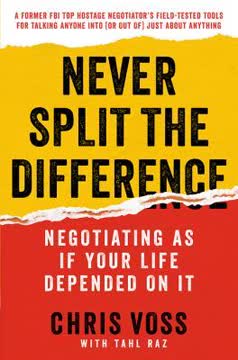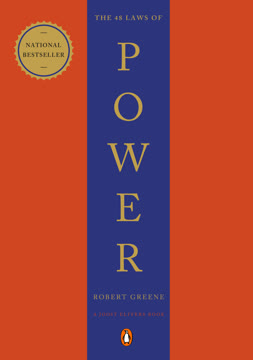मुख्य निष्कर्ष
1. तैयारी सबसे महत्वपूर्ण: अपनी और सामने वाले की इच्छाओं को जानें
जब आप फोन उठाने या बातचीत में उतरने जा रहे हों, तो सुनिश्चित करें कि आपके पास सभी जरूरी जानकारी हो और आप उसे पूरी तरह समझते हों ताकि आप सही ढंग से काम कर सकें।
स्वयं की समझ और स्पष्टता। सफल बातचीत की शुरुआत अपने उद्देश्यों, सीमाओं और अनिवार्य बातों की गहरी समझ से होती है। अपनी आदर्श स्थिति, स्वीकार्य शर्तें और वह बिंदु जहाँ आप बातचीत छोड़ सकते हैं, पहले से तय कर लें। यह स्पष्टता आपको एक मार्गदर्शक प्रदान करती है और दबाव या भावनाओं में बहने से बचाती है।
सहानुभूति और दृष्टिकोण समझना। उतना ही जरूरी है कि आप सामने वाले की प्रेरणाओं, आवश्यकताओं और सीमाओं को समझें। उनकी जगह खुद को रखकर उनकी स्थिति का अनुमान लगाएं और ऐसे क्षेत्र खोजें जहाँ दोनों पक्षों को लाभ हो सके। यह सहानुभूतिपूर्ण दृष्टिकोण विश्वास और सहयोग को बढ़ावा देता है, जिससे अधिक रचनात्मक और टिकाऊ समझौते संभव होते हैं।
सावधानीपूर्वक जांच और बाजार अनुसंधान। अपने आप को प्रासंगिक आंकड़ों, उद्योग मानकों और प्रतिस्पर्धियों की जानकारी से लैस करें। उचित मूल्य सीमा, बाजार के रुझान और संभावित जोखिमों को जानना आपको मजबूती से बातचीत करने और सूचित निर्णय लेने में सक्षम बनाता है। इसमें बातचीत के संदर्भ को समझना भी शामिल है, जैसे समय की पाबंदी, प्रतिष्ठा के कारक और अन्य निर्णयकर्ताओं की उपस्थिति।
2. सहनशक्ति और मानसिक दृढ़ता: वार्ताकार की रीढ़
सहनशक्ति का मतलब है जब हालात कठिन हों और दरवाजे बंद हों, तब भी हिम्मत बनाए रखना।
लचीलापन और दृढ़ता। बातचीत हमेशा आसान नहीं होती; इसके लिए सहनशक्ति, मानसिक मजबूती और असफलताओं से उबरने की क्षमता चाहिए। ऐसी सोच विकसित करें जो चुनौतियों को स्वीकार करे, गलतियों से सीखे और विपरीत परिस्थितियों में भी टिके रहे। इसमें सकारात्मक दृष्टिकोण बनाए रखना, भावनाओं को नियंत्रित करना और अपने लक्ष्यों पर ध्यान केंद्रित रखना शामिल है।
मनोवृत्ति और कल्पना। अपनी सफलता की क्षमता पर दृढ़ विश्वास विकसित करें। बातचीत की प्रक्रिया की कल्पना करें, संभावित बाधाओं का अनुमान लगाएं और अपने जवाबों का मानसिक अभ्यास करें। यह मानसिक तैयारी आत्मविश्वास बढ़ाती है और चिंता कम करती है, जिससे दबाव में भी आप बेहतरीन प्रदर्शन कर सकें।
स्वयं की देखभाल और स्वास्थ्य। सहनशक्ति केवल मानसिक मजबूती नहीं है; इसके लिए शारीरिक और भावनात्मक स्वास्थ्य भी जरूरी है। स्वस्थ भोजन करें, नियमित व्यायाम करें, पर्याप्त नींद लें और तनाव कम करने वाली गतिविधियों में भाग लें। स्वस्थ शरीर और मन बातचीत के दौरान फोकस, स्पष्टता और लचीलापन बनाए रखने के लिए आवश्यक हैं।
3. संचार है कुंजी: सुनें, सहानुभूति रखें और स्पष्ट रहें
संचार (सक्रिय सुनना, समझने के लिए सुनना, समझाने के लिए बोलना)।
सक्रिय सुनना और सहानुभूति। प्रभावी संचार सफल बातचीत की नींव है। सक्रिय सुनने का अभ्यास करें, जिसमें मौखिक और गैर-मौखिक संकेतों पर ध्यान देना, स्पष्ट प्रश्न पूछना और मुख्य बिंदुओं का सारांश देना शामिल है। सामने वाले के दृष्टिकोण को स्वीकार कर सहानुभूति दिखाएं और उनकी आवश्यकताओं व चिंताओं में वास्तविक रुचि लें।
स्पष्टता और संक्षिप्तता। अपनी बातों को स्पष्ट, संक्षिप्त और प्रभावशाली ढंग से रखें। जटिल शब्दावली, अस्पष्टता और भावनात्मक भाषा से बचें। अपने तर्कों का समर्थन आंकड़ों, प्रमाणों और तार्किक सोच से करें। सीधे और आत्मविश्वास से बोलें, लेकिन हमेशा सम्मानजनक और पेशेवर रहें।
गैर-मौखिक संचार। अपनी और सामने वाले की शारीरिक भाषा और चेहरे के भावों के प्रति सजग रहें। आँखों में आँखें डालकर बात करें, खुला और आत्मविश्वासी मुद्रा अपनाएं, और बेचैनी या अन्य ध्यान भटकाने वाले व्यवहार से बचें। गैर-मौखिक संकेत आत्मविश्वास, ईमानदारी और विश्वसनीयता दर्शाते हैं, जो आपकी बातचीत को प्रभावी बनाते हैं।
4. रणनीतियाँ और तकनीकें: सफलता के लिए उपकरण
रणनीति बिना तकनीक के जीत का सबसे धीमा रास्ता है। तकनीक बिना रणनीति के हार से पहले की शोरगुल है।
समेकित बनाम वितरणात्मक बातचीत। समेकित (दोनों पक्षों के लिए लाभकारी) और वितरणात्मक (एक पक्ष के लिए जीत, दूसरे के लिए हार) बातचीत के बीच अंतर समझें। दोनों पक्षों के लिए मूल्य सृजित करने वाले समेकित समाधान की कोशिश करें, लेकिन अपनी सुरक्षा के लिए वितरणात्मक तकनीकों का उपयोग करने के लिए तैयार रहें।
एंकरिंग और फ्रेमिंग। एंकरिंग का उपयोग करके सामने वाले की मूल्य धारणा को सूक्ष्म रूप से प्रभावित करें। अपने प्रस्तावों को इस तरह प्रस्तुत करें कि उनके लाभ उजागर हों और कमियाँ कम दिखें। यह भी जानें कि सामने वाला बातचीत को कैसे फ्रेम कर रहा है और उसे अपने पक्ष में बदलें।
तत्कालता और कमी पैदा करना। समय सीमा, सीमित उपलब्धता या प्रतिस्पर्धी प्रस्तावों को उजागर करके तत्कालता का भाव पैदा करें। कमी की तकनीक से अपने प्रस्तावों के मूल्य को बढ़ाएं। हालांकि, नैतिकता बनाए रखें और झूठी या भ्रामक जानकारी देने से बचें।
5. शक्ति संतुलन: मैदान को बराबर बनाना
भिन्नताएँ सौदों को आगे बढ़ाती हैं।
शक्ति असंतुलन की पहचान। जब सामने वाले के पास आपसे अधिक शक्ति, संसाधन या दबाव हो, तो इसे पहचानें। यह जागरूकता आपको अपनी रणनीति और तकनीकों को समायोजित करने में मदद करती है।
अपना BATNA मजबूत करें। अपने सर्वोत्तम वैकल्पिक समझौते (BATNA) को मजबूत करें, अन्य विकल्पों की खोज करें और आकस्मिक योजनाएं बनाएं। एक मजबूत BATNA आपको खराब सौदे से दूर जाने का आत्मविश्वास देती है और आपकी बातचीत की ताकत बढ़ाती है।
जानकारी और विशेषज्ञता का लाभ उठाएं। सामने वाले, उनकी आवश्यकताओं और सीमाओं के बारे में अधिक से अधिक जानकारी इकट्ठा करें। अपनी विशेषज्ञता और ज्ञान का उपयोग मूल्य सृजित करने और बातचीत को प्रभावित करने के लिए करें। अपनी अनूठी ताकतों को उजागर करें और बताएं कि वे सामने वाले के लिए कैसे लाभकारी हो सकती हैं।
6. 21वीं सदी की बातचीत: डिजिटल युग के अनुसार ढलना
हम सफल होंगे क्योंकि हम युवा हैं और कभी हार नहीं मानते।
सोशल मीडिया और ऑनलाइन उपकरण। लिंक्डइन जैसे सोशल मीडिया प्लेटफॉर्म का उपयोग संभावित साझेदारों की खोज, संबंध बनाने और जानकारी इकट्ठा करने के लिए करें। संचार, सहयोग और जानकारी साझा करने के लिए ऑनलाइन उपकरणों का लाभ उठाएं।
साइबर सुरक्षा और डेटा संरक्षण। डेटा उल्लंघनों, रैंसमवेयर हमलों और अन्य साइबर खतरों के प्रति सतर्क रहें। अपने डेटा की सुरक्षा के लिए सुरक्षा उपाय लागू करें और आवश्यक होने पर हैकर्स के साथ बातचीत के लिए तैयार रहें।
दूरस्थ संचार और वर्चुअल बैठकें। वीडियो कॉन्फ्रेंसिंग, ईमेल और त्वरित संदेश सेवा के माध्यम से दूरस्थ संचार की कला में महारत हासिल करें। अपनी संचार शैली को वर्चुअल माहौल के अनुसार ढालें और गैर-मौखिक संकेतों का ध्यान रखें।
7. वास्तविक जीवन में उपयोग: घर, करियर और बड़े सौदे
इंतजार करने की बात नहीं है; अपनी रचनात्मकता को समझने और उस आवाज़ को खोजने की बात है जो कहती है, ‘मैं जारी रखूँगा’, भले ही सारे रास्ते बंद लगें।
घर खरीदना और बेचना। रियल एस्टेट बाजार को समझें, संपत्ति के मूल्य का आकलन करें और एजेंटों व विक्रेताओं के साथ प्रभावी बातचीत करें। खराब सौदे से दूर जाने और वैकल्पिक विकल्पों की खोज के लिए तैयार रहें।
करियर उन्नति और वेतन वार्ता। अपने नियोक्ता को अपनी मूल्यवत्ता दिखाएं, अपने करियर लक्ष्यों को स्पष्ट करें और उचित वेतन व लाभों के लिए बातचीत करें। अपनी उपलब्धियों, कौशल और बाजार मूल्य पर चर्चा के लिए तैयार रहें।
बड़े सौदे और उच्च दांव वाले लेन-देन। कार खरीद, व्यापार साझेदारी और बड़े अनुबंधों जैसे उच्च दांव वाले लेन-देन में बातचीत के सिद्धांत लागू करें। पूरी सावधानी से जांच करें, विशेषज्ञ सलाह लें और यदि शर्तें अनुकूल न हों तो सौदा छोड़ने के लिए तैयार रहें।
8. सौदे की कला: सब कुछ संबंधों के बारे में है
सबसे मधुर सौदे वे होते हैं जहाँ दोनों पक्ष किसी न किसी रूप में लाभान्वित होते हैं।
विश्वास और मेलजोल बनाना। बातचीत केवल एक विशिष्ट परिणाम पाने के लिए नहीं है; यह दीर्घकालिक संबंध बनाने के बारे में भी है। सकारात्मक और सहयोगी माहौल बनाने, विश्वास बढ़ाने और सामने वाले के प्रति सम्मान दिखाने पर ध्यान दें।
ईमानदारी और नैतिकता बनाए रखना। बातचीत ईमानदारी, पारदर्शिता और नैतिक व्यवहार के साथ करें। धोखा, चालाकी और आक्रामक तकनीकों से बचें। ईमानदारी की प्रतिष्ठा एक मूल्यवान संपत्ति है जो आपको लंबे समय तक लाभ पहुंचाएगी।
विन-विन समाधान खोजें। ऐसे परिणामों के लिए प्रयास करें जो दोनों पक्षों को लाभ पहुंचाएं और पारस्परिक मूल्य सृजित करें। अवसर खोजें जिससे संसाधनों का विस्तार हो, मूलभूत आवश्यकताओं को पूरा किया जा सके और टिकाऊ साझेदारी बन सके। याद रखें कि सफल बातचीत दूसरों की कीमत पर जीतने के बारे में नहीं, बल्कि सभी के लिए बेहतर भविष्य बनाने के बारे में है।
अंतिम अपडेट:
FAQ
What is The Art of Negotiation: How To Get What You Want by Tim Castle about?
- Comprehensive negotiation guide: The book is a practical manual covering negotiation fundamentals, real-world examples, and advanced tactics for both personal and professional scenarios.
- Emphasis on mindset and stamina: Tim Castle highlights the importance of mental toughness, self-awareness, and perseverance, using case studies of successful negotiators.
- Modern and interactive approach: The book blends classic negotiation principles with 21st-century realities, including digital tools, and offers activities and resources for experiential learning.
Why should I read The Art of Negotiation: How To Get What You Want by Tim Castle?
- Essential life skill: Negotiation is a critical skill for everyday life and career advancement, impacting relationships, wealth, and business success.
- Actionable strategies and real examples: The book combines theory with Tim Castle’s personal experiences and practical advice, making it accessible and immediately useful.
- Focus on integrity and relationships: Castle teaches negotiation as a tool for building trust and long-term value, not just winning at all costs.
What are the key takeaways from The Art of Negotiation: How To Get What You Want by Tim Castle?
- Power of silence and listening: Silence is a strategic tool for controlling negotiations and encouraging the other party to reveal information.
- Preparation and BATNA: Success hinges on thorough preparation, understanding your Best Alternative to a Negotiated Agreement, and anticipating the other side’s moves.
- Trust, humor, and authenticity: Building trust, using humor to ease tension, and negotiating with honesty lead to better, more sustainable outcomes.
What are the main negotiation concepts explained in The Art of Negotiation: How To Get What You Want by Tim Castle?
- Distributive vs. integrative negotiation: Distributive is competitive and short-term, while integrative focuses on cooperation, problem-solving, and long-term relationships.
- Seven Elements of Effective Negotiation: Interests, Legitimacy, Relationships, Alternatives, Options, Commitments, and Communication form the core framework.
- Phases of negotiation: The process includes Preparation, Exchange of Information, Bargaining, and Closing, with emphasis on thorough preparation and follow-up.
How does Tim Castle define negotiation in The Art of Negotiation: How To Get What You Want?
- Beneficial agreement process: Negotiation is described as reaching agreements that nourish long-term relationships, wealth, and business.
- Interpersonal decision-making: Castle references negotiation as a necessary process when objectives can’t be achieved alone, emphasizing collaboration.
- Mutual benefit focus: The goal is to create value for all parties, moving beyond transactional exchanges to integrative, win-win solutions.
What preparation advice does Tim Castle offer in The Art of Negotiation: How To Get What You Want?
- Research and self-awareness: Spend time understanding the other party, their style, and your own goals, non-negotiables, and alternatives.
- Identify negotiation type: Tailor your strategy based on whether it’s a one-issue, multi-issue, or time-based negotiation.
- Team alignment: Ensure your negotiating team is unified and clear on roles to avoid internal conflict or sabotage.
What is BATNA and why is it important according to The Art of Negotiation: How To Get What You Want by Tim Castle?
- Definition and origin: BATNA stands for Best Alternative to a Negotiated Agreement, a fallback plan if negotiations fail, originating from Fisher and Ury’s Getting to Yes.
- Source of negotiation power: A strong BATNA gives you leverage and confidence, reducing pressure to accept poor terms.
- Preparation necessity: Knowing your BATNA and estimating the other party’s alternatives is crucial for effective negotiation planning.
How does Tim Castle recommend handling emotions like anxiety and anger in negotiation?
- Recognize emotional triggers: Anxiety often arises before and early in negotiations, while anger can surface during bargaining.
- Manage destructive emotions: Anger can damage trust and relationships, while anxiety leads to weaker offers; both must be managed for success.
- Use calming techniques: Deep breathing, pausing, and maintaining a positive mindset help control emotions and improve negotiation outcomes.
What role does non-verbal communication play in negotiation according to The Art of Negotiation: How To Get What You Want by Tim Castle?
- Powerful non-verbal cues: Body language, facial expressions, and micro-expressions reveal true emotions and can influence negotiation results.
- Power posing benefits: Adopting confident postures increases presence, reduces stress, and boosts risk tolerance.
- Self-awareness tools: Techniques like the Johari Window help negotiators understand how they are perceived and improve team dynamics.
How does Tim Castle explain the use of silence in negotiation in The Art of Negotiation: How To Get What You Want?
- Silence as a control tool: Silence helps control the pace and emotional tone, giving you time to think and prompting the other party to share more.
- Avoid premature agreement: Filling silences with quick responses or justifications can weaken your position and signal agreement too soon.
- Team coordination: In pair negotiations, pre-negotiation syncing ensures silence is used strategically without accidental interruptions.
What strategies and tactics for successful negotiation does Tim Castle share in The Art of Negotiation: How To Get What You Want?
- Negotiate the negotiation: Start by agreeing on the negotiation process itself, setting expectations and reducing tension.
- Build trust and disclose early: Show trust first and be upfront about your interests to foster openness and sometimes speed up deals.
- Create urgency and leverage BATNA: Use urgency to move negotiations forward and rely on your BATNA for confidence and power.
How can I apply Tim Castle’s advice from The Art of Negotiation: How To Get What You Want to salary and big-ticket item negotiations?
- Salary negotiation: Define your ideal, acceptable, and no-go salary figures, present all desired elements upfront, and maintain rapport and flexibility.
- Big-ticket items: Break negotiations into steps, research market conditions, and use alternatives to strengthen your position.
- Emotional management: Set clear budgets, understand motivations, and build genuine relationships to avoid overspending and secure better deals.
समीक्षाएं
नेगोशिएशन की कला को मिली-जुली प्रतिक्रियाएँ मिली हैं, जिसकी औसत रेटिंग 3.77/5 है। पाठक इसकी व्यावहारिक सलाह और बातचीत कौशल सुधारने के सामान्य सिद्धांतों की सराहना करते हैं। कुछ इसे प्रेरणादायक और आत्मविश्वास बढ़ाने वाला मानते हैं, जबकि अन्य इसे सरल लेकिन क्रांतिकारी नहीं समझते। यह पुस्तक बातचीत की तकनीकों को व्यापक रूप से कवर करने के लिए प्रशंसित है, चाहे वह रोजमर्रा की स्थितियाँ हों या कॉर्पोरेट सौदे। हालांकि, कुछ पाठकों को इसकी सामग्री सूखी और धीमी लगती है। कुल मिलाकर, यह उन लोगों के लिए एक उपयोगी संसाधन माना जाता है जो अपनी बातचीत की क्षमता बढ़ाना चाहते हैं, हालांकि इसके आकर्षण और गहराई को लेकर मतभेद भी हैं।
Similar Books














